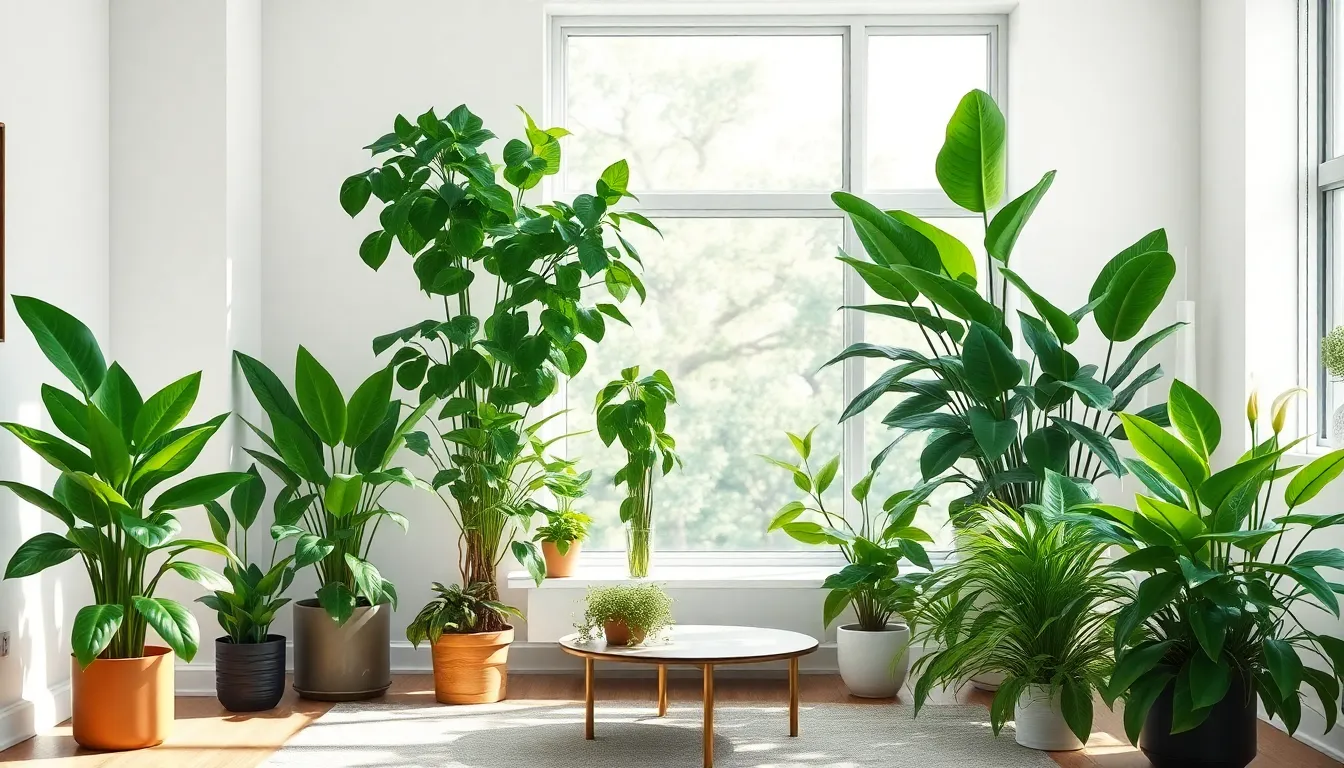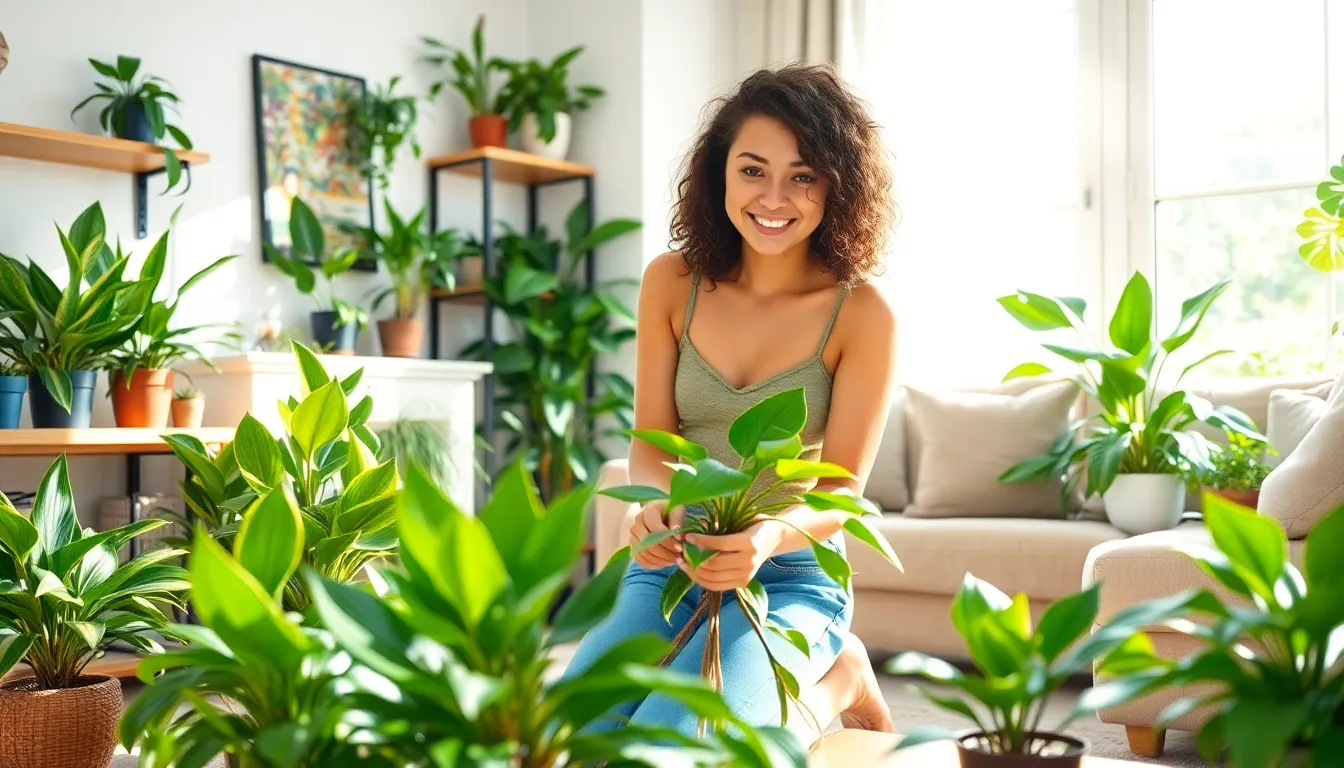Indoor plants aren’t just the latest trend; they’re a secret weapon for transforming any space into a vibrant oasis. Imagine walking into a room filled with lush greenery that not only looks good but also boosts your mood and purifies the air. Who wouldn’t want a little slice of nature indoors?
Table of Contents
ToggleBenefits of Indoor Plants
Indoor plants offer numerous advantages that extend beyond visual appeal. They contribute significantly to a healthier living environment and enhance overall well-being.
Improved Air Quality
Indoor plants effectively purify the air, removing toxins like formaldehyde and benzene. Research shows that they can reduce levels of carbon dioxide, leading to fresher indoor air. Plants like peace lilies and spider plants thrive indoors and excel at absorbing these harmful substances. High humidity levels from plants also help reduce dryness, benefiting respiratory health. Frequent exposure to cleaner air promotes better focus and productivity, further establishing the importance of these natural additions.
Psychological Benefits
The presence of indoor plants positively affects mental health, reducing stress and anxiety. Studies indicate that even just viewing greenery can elevate mood and foster relaxation. Many people experience increased feelings of happiness and contentment when surrounded by nature indoors. Additionally, caring for plants can provide a sense of accomplishment and purpose, enhancing emotional well-being. Natural surroundings tend to inspire creativity and improve cognitive function, making indoor plants essential for a thriving home atmosphere.
Popular Types of Indoor Plants

Indoor plants come in various types, each catering to different conditions and preferences. Understanding the popular options can enhance any indoor setting.
Low-Light Plants
Low-light plants thrive in areas with minimal sunlight. Snake plants adapt well to darker spaces, requiring little care and adding a touch of elegance. Pothos, known for its trailing vines, creates visual interest even in low-light corners. ZZ plants feature glossy leaves and tolerate neglect, making them ideal for busy individuals. Peace lilies, aside from purifying the air, bloom even in shade. These options serve as excellent choices for homeowners looking to enhance ambiance without direct light.
Easy-to-Care Plants
Easy-to-care plants suit individuals with busy lifestyles. Spider plants are resilient and propagate effortlessly. Their air-purifying qualities enhance indoor air quality, providing a healthier environment. Rubber plants adapt to various conditions and require minimal watering, making them a favorite among newcomers. ZZ plants, again, showcase versatility in care routines while offering striking aesthetics. These plants contribute to a low-maintenance yet appealing indoor garden, making them ideal for any home.
Care Tips for Indoor Plants
Caring for indoor plants involves understanding their specific needs. Proper attention ensures vibrant, healthy greenery.
Watering Techniques
Watering strategies depend on the plant type and environmental conditions. Checking soil moisture helps determine when to water; it’s essential to avoid overwatering. For most plants, allowing the top inch of soil to dry before watering promotes healthy roots. Keeping a consistent watering schedule aligns with the plant’s growth cycle, with frequency adjusting during different seasons. Succulents and cacti require less water, while tropical species thrive on more moisture.
Light Requirements
Light conditions significantly affect plant health and growth. Placing plants near windows maximizes exposure to natural sunlight; however, too much direct light can cause leaf burn. Understanding each plant’s light preference aids in placement. Low-light plants like snake plants do well in shadier spaces, while plants such as succulents require bright light. Monitoring plant responses to their environment allows for adjustments, ensuring optimal light conditions.
Soil and Fertilization
Soil choice directly influences a plant’s access to nutrients. Well-draining potting mixes generally support healthy growth for most indoor plants. Replacing soil every couple of years refreshes nutrients and improves aeration. Fertilizing during the growing season enhances plant vigor; using balanced fertilizers works well for many species. Diluting fertilizer concentration helps prevent root burn, especially for sensitive varieties.
Designing with Indoor Plants
Designing with indoor plants enhances the aesthetic appeal and functionality of any space. Thoughtful incorporation creates a lively and serene environment.
Placement Ideas
Spaces benefit from strategic placement of indoor plants. Corners can transform with tall plants like snake plants or dracaenas, grounding the room. Shelves may receive a boost from trailing plants, such as pothos, adding depth. Tables and countertops shine with small pots of succulents or peace lilies, brightening workspaces. Windowsills offer an ideal spot for sun-loving plants like cacti, maximizing natural light, while hanging planters can draw the eye upward, making small areas feel larger. Overall, every space offers unique opportunities for creative plant placement.
Combining Different Plants
Combining different plants showcases diversity and dynamism. Grouping plants with similar care needs simplifies maintenance while creating an appealing visual arrangement. Contrast leaf shapes and colors to create striking displays; for instance, pairing the broad leaves of a rubber plant with the delicate fronds of a fern enhances texture. Use varying heights to create layers, positioning taller plants at the back and shorter ones at the front. Consider using a color palette that complements the room’s decor, which ties everything together seamlessly. Careful selection promotes balance and harmony within indoor spaces.
Indoor plants are essential for anyone looking to enhance their living space. They not only beautify the environment but also contribute to better air quality and improved mental well-being. With a variety of options available for different lighting conditions and care levels, there’s a perfect plant for every home and lifestyle.
By incorporating indoor plants thoughtfully, individuals can create vibrant and inviting atmospheres that promote relaxation and creativity. Whether it’s a low-maintenance snake plant or a cheerful pothos, these green companions can transform any area into a refreshing sanctuary. Embracing indoor gardening can lead to a healthier and happier home, making it a rewarding endeavor for all.





